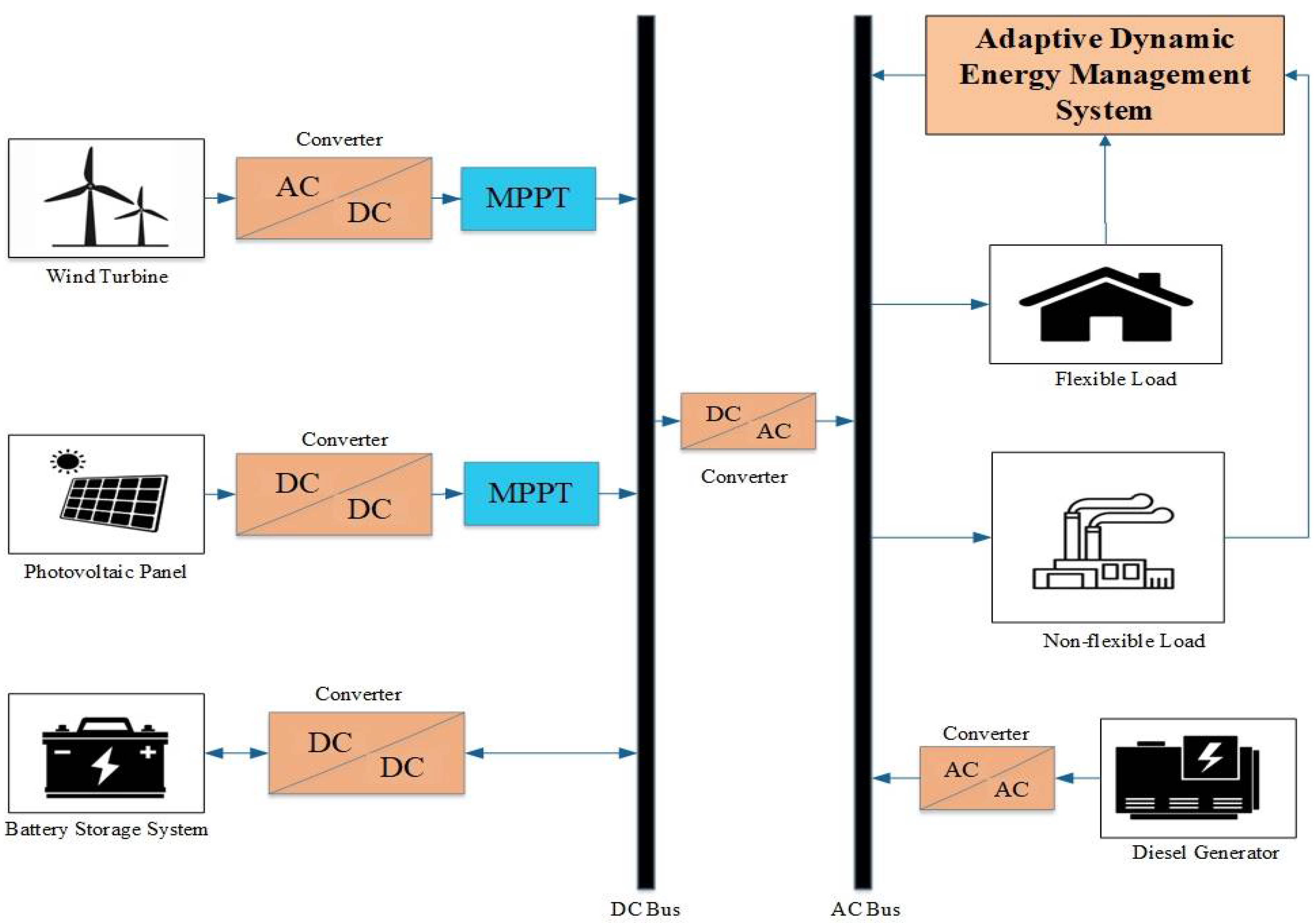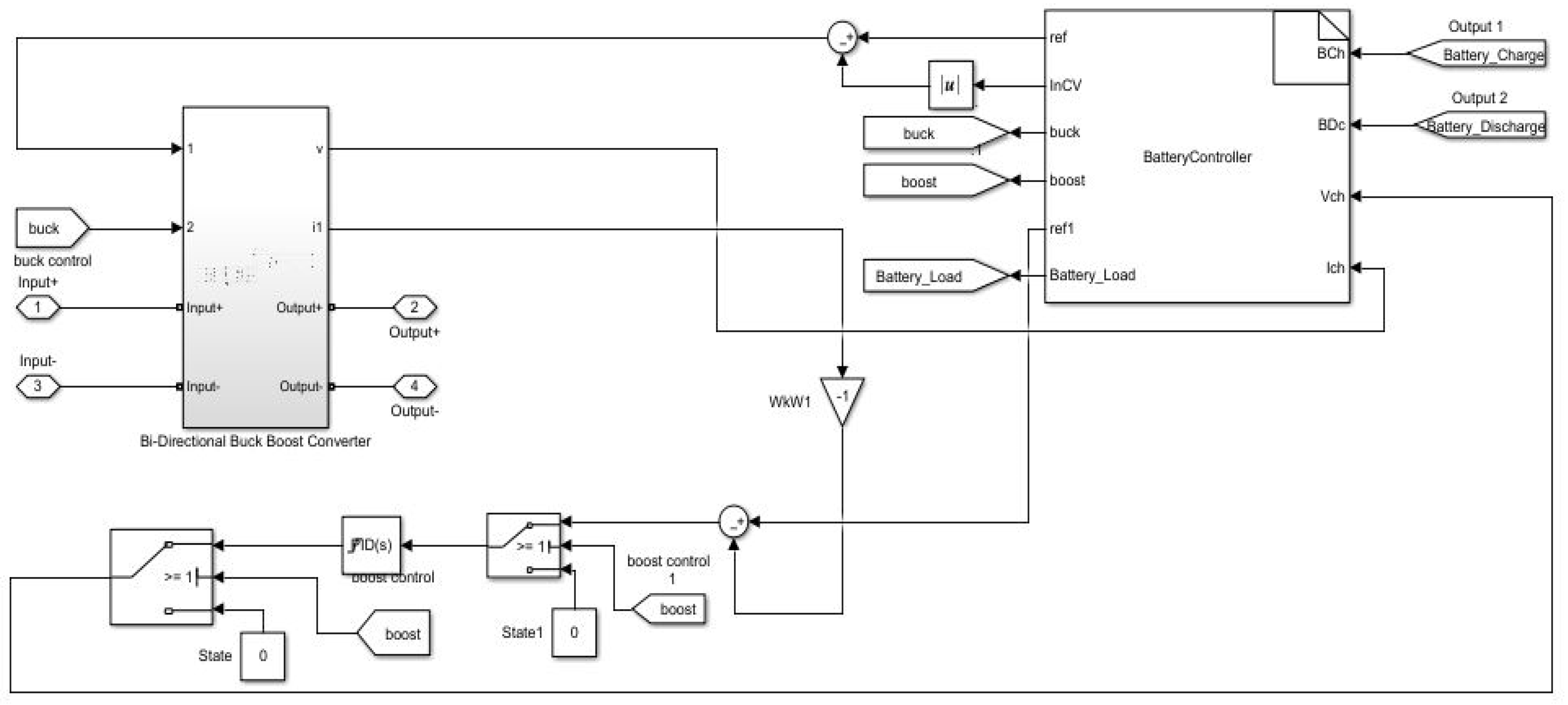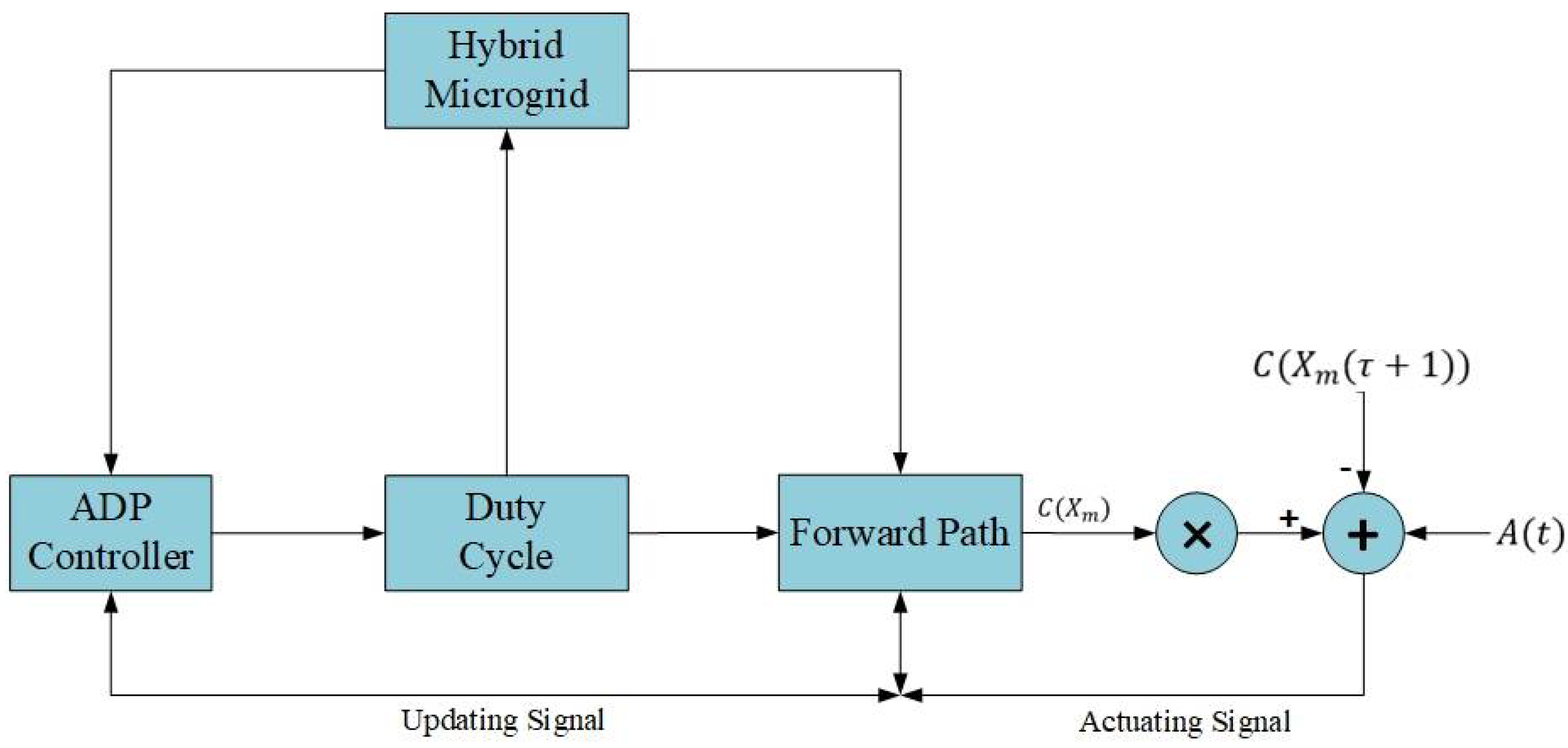Adaptive Dynamic Control Based Optimization of Renewable Energy Resources for Grid-Tied Microgrids
Abstract
:1. Introduction
2. Hybrid Microgrid Model
2.1. Photovoltaic System
- (1)
- To promote sustainable growth ecologically
- (2)
- To produce emission free electricity without undue environmental damage
- (3)
- To improve grid security
2.2. Diesel Generator Operation
2.3. Wind Turbine Operation
2.4. Battery Energy Storage System
3. Designing of Adaptive-Dynamic-Control-Based Optimization System
4. Simulation and Results
5. Comparison
6. Conclusions
Author Contributions
Funding
Institutional Review Board Statement
Informed Consent Statement
Data Availability Statement
Acknowledgments
Conflicts of Interest
References
- Obama, B. The irreversible momentum of clean energy. Science 2017, 355, 126–129. [Google Scholar] [CrossRef] [Green Version]
- Wei, Q.; Liu, D.; Liu, Y.; Song, R. Optimal constrained self-learning battery sequential management in microgrid via adaptive dynamic programming. IEEE/CAA J. Autom. Sin. 2016, 4, 168–176. [Google Scholar] [CrossRef]
- Nan, W.; Honglei, W. Real time energy management and control strategy for micro-grid based on deep learning adaptive dynamic programming. J. Clean. Prod. 2018, 204, S0959652618327665. [Google Scholar]
- Wei, Q.; Liu, D.; Lewis, F.L.; Liu, Y.; Zhang, J. Mixed Iterative Adaptive Dynamic Programming for Optimal Battery Energy Control in Smart Residential Microgrids. IEEE Trans. Ind. Electron. 2017, 64, 4110–4120. [Google Scholar] [CrossRef]
- Yin, L.; Yu, T.; Yang, B.; Zhang, X. Adaptive deep dynamic programming for integrated frequency control of multi-area multi-microgrid systems. Neurocomputing 2019, 344, 49–60. [Google Scholar] [CrossRef]
- Shuai, H.; Fang, J.; Ai, X.; Tang, Y.; Wen, J.; He, H. Stochastic optimization of economic dispatch for microgrid based on approximate dynamic programming. IEEE Trans. Smart Grid 2018, 10, 2440–2452. [Google Scholar] [CrossRef] [Green Version]
- Zeng, P.; Li, H.; He, H.; Li, S. Dynamic energy management of a microgrid using approximate dynamic programming and deep recurrent neural network learning. IEEE Trans. Smart Grid 2018, 10, 4435–4445. [Google Scholar] [CrossRef] [Green Version]
- Shi, J.; Yue, D.; Huang, C.; Dou, C. Adaptive distributed secondary control of microgrids via single-network adaptive dynamic programming method. Int. Trans. Electr. Energy Syst. 2018, 28, e2549. [Google Scholar] [CrossRef]
- Shahryari, E.; Shayeghi, H.; Mohammadi-ivatloo, B.; Moradzadeh, M. An improved incentive-based demand response program in day-ahead and intra-day electricity markets. Energy 2018, 155, 205–214. [Google Scholar] [CrossRef]
- Zhao, B.; Xue, M.; Zhang, X.; Wang, C.; Zhao, J. An MAS based energy management system for a stand-alone microgrid at high altitude. Appl. Energy 2015, 143, 251–261. [Google Scholar] [CrossRef] [Green Version]
- Talari, S.; Yazdaninejad, M.; Haghifam, M.R. Stochastic-based scheduling of the microgrid operation including wind turbines, photovoltaic cells, energy storages and responsive loads. IET Gener. Transm. Distrib. 2015, 9, 1498–1509. [Google Scholar] [CrossRef]
- Pourmousavi, S.A.; Nehrir, M.H.; Sharma, R.K. Multi-Timescale Power Management for Islanded Microgrids Including Storage and Demand Response. IEEE Trans. Smart Grid 2015, 6, 1185–1195. [Google Scholar] [CrossRef] [Green Version]
- Bertsekas, D.P. Dynamic Programming and Optimal Control; Athena Scientific: Belmont, MA, USA, 2005. [Google Scholar]
- Venayagamoorthy, G.K.; Sharma, R.K.; Gautam, P.K.; Ahmadi, A. Dynamic energy management system for a smart microgrid. IEEE Trans. Neural Netw. Learn. Syst. 2016, 27, 1643–1656. [Google Scholar] [CrossRef]
- Thongam; Singh, J.; Ouhrouche, M. MPPT control methods in wind energy conversion systems. Fundam. Adv. Top. Wind. Power 2011, 15, 339–360. [Google Scholar]
- Liu, D.; Wei, Q.; Wang, D.; Yang, X.; Li, H. Adaptive Dynamic Programming with Applications in Optimal Control; Springer International Publishing: Berlin, Germany, 2017. [Google Scholar]
- Nikolaidis, P.; Poullikkas, A. Co-optimization of active power curtailment, load shedding and spinning reserve deficits through hybrid approach: Comparison of electrochemical storage technologies. IET Renew. Power Gener. 2022, 16, 92–104. [Google Scholar] [CrossRef]
- Nikolaidis, P.; Poullikkas, A. A novel cluster-based spinning reserve dynamic model for wind and PV power reinforcement. Energy 2021, 234, 121270. [Google Scholar] [CrossRef]
- Nikolaidis, P.; Chatzis, S.; Poullikkas, A. Renewable energy integration through optimal unit commitment and electricity storage in weak power networks. Int. J. Sustain. Energy 2018, 38, 398–414. [Google Scholar] [CrossRef]
- Furqan, A.; Talha, M.; Kim, S.H. Robust frequency and voltage stability control strategy for standalone AC/DC hybrid microgrid. Energies 2017, 10, 760. [Google Scholar]
- Asghar, F.; Talha, M.; Kim, S.H. Fuzzy logic-based intelligent frequency and voltage stability control system for standalone microgrid. Int Trans Electr Energ Syst. 2017, 28, e2510. [Google Scholar] [CrossRef]
- Mori, M.; Gutiérrez, M.; Sekavčnik, M.; Drobnič, B. Modelling and Environmental Assessment of a Stand-Alone Micro-Grid System in a Mountain Hut Using Renewables. Energies 2021, 15, 202. [Google Scholar] [CrossRef]
- Rodríguez-Molina, J.; Martínez, J.-F.; Castillejo, P. A Study on Applicability of Distributed Energy Generation, Storage and Consumption within Small Scale Facilities. Energies 2016, 9, 745. [Google Scholar] [CrossRef] [Green Version]
- Pothireddy, K.M.R.; Vuddanti, S.; Salkuti, S.R. Impact of Demand Response on Optimal Sizing of Distributed Generation and Customer Tariff. Energies 2022, 15, 190. [Google Scholar] [CrossRef]
- Nasir, T.; Raza, S.; Abrar, M.; Muqeet, H.A.; Jamil, H.; Qayyum, F.; Cheikhrouhou, O.; Alassery, F.; Hamam, H. Optimal Scheduling of Campus Microgrid Considering the Electric Vehicle Integration in Smart Grid. Sensors 2021, 21, 7133. [Google Scholar] [CrossRef]
- Hu, J.; Zhu, J.; Dorrell, D.; Guerrero, J. Virtual Flux Droop Method—A New Control Strategy of Inverters in Microgrids. IEEE Trans. Power Electron. 2013, 29, 4704–4711. [Google Scholar] [CrossRef] [Green Version]


















| Description | Parameters | Values | Unit |
|---|---|---|---|
| Diesel Generator Rated Power | 2 | MW | |
| Photovoltaic Rated Power | 1.2 | MW | |
| Wind Turbine Rated Power | 2 | MW | |
| Battery Rated Power | 500 | kW | |
| Bus Voltages | 5000 | V | |
| Hybrid System Frequency | 60 | Hz | |
| Minimum Battery SOC | 10 | % | |
| Maximum Battery SOC | 90 | % | |
| Simulation Stop Time | 54 | s |
Publisher’s Note: MDPI stays neutral with regard to jurisdictional claims in published maps and institutional affiliations. |
© 2022 by the authors. Licensee MDPI, Basel, Switzerland. This article is an open access article distributed under the terms and conditions of the Creative Commons Attribution (CC BY) license (https://creativecommons.org/licenses/by/4.0/).
Share and Cite
Majeed, M.A.; Asghar, F.; Hussain, M.I.; Amjad, W.; Munir, A.; Armghan, H.; Kim, J.-T. Adaptive Dynamic Control Based Optimization of Renewable Energy Resources for Grid-Tied Microgrids. Sustainability 2022, 14, 1877. https://doi.org/10.3390/su14031877
Majeed MA, Asghar F, Hussain MI, Amjad W, Munir A, Armghan H, Kim J-T. Adaptive Dynamic Control Based Optimization of Renewable Energy Resources for Grid-Tied Microgrids. Sustainability. 2022; 14(3):1877. https://doi.org/10.3390/su14031877
Chicago/Turabian StyleMajeed, Muhammad Asghar, Furqan Asghar, Muhammad Imtiaz Hussain, Waseem Amjad, Anjum Munir, Hammad Armghan, and Jun-Tae Kim. 2022. "Adaptive Dynamic Control Based Optimization of Renewable Energy Resources for Grid-Tied Microgrids" Sustainability 14, no. 3: 1877. https://doi.org/10.3390/su14031877







